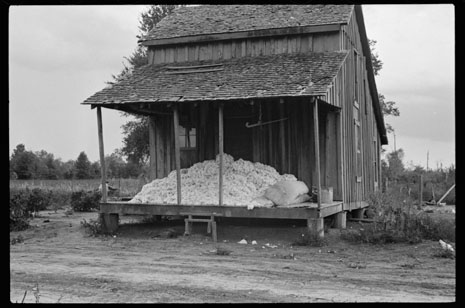
FAYETTEVILLE, Ark. – Three University of Arkansas faculty members will take part in a panel discussion at the "Art for the Citizen" symposium being held this week at Crystal Bridges Museum of American Art in Bentonville.
The symposium brings together creative thinkers of various disciplines from surrounding institutions to explore artists from the first half of the 20th century whose work conveys political and social messages – from paintings and photography to the cinema of Charlie Chaplin.
Greg Herman, associate professor of architecture in the Fay Jones School of Architecture, will participate in the symposium's closing panel discussion, "This Land: Picturing a Changing America in the 1930s and 1940s," from 7-9 p.m. Friday, Sept. 27. He'll be joined by two fellow University of Arkansas professors, Jeannie Whayne, professor of history, and Patsy Watkins, professor of print journalism, both in the J. William Fulbright College of Arts and Sciences; Manuela Well-Off-Man, assistant curator at Crystal Bridges; and Gayle Seymour, professor of art and associate dean at the University of Central Arkansas.
The name of their discussion is also the title of an exhibit on display at the museum through January. In their discussion, these panelists will analyze artists' responses to major natural events and the changing rural and urban landscapes of United States prior to World War II. They will consider the artists' different approaches, as well as the various government-sponsored art programs of that era.
Herman, Whayne and Watkins were advisors to the concurrent This Land exhibit assembled by Crystal Bridges. The exhibit includes some 45 paintings, drawings, prints and photographs of the United States in the 1930s and 1940s, generally of rural areas, much of it depicting poverty.
Herman said his particular interest is the architecture of Farm Security Administration (FSA) resettlement housing, which he's researched for some time.
Many of the photographs that document both the architecture and general conditions of that period were taken by now well-known photographers: Carl Mydans and Margaret Bourke-White, among them. As part of relief work, the Works Progress Administration hired photographers, authors, architects, artists and other creative professionals.
"The architecture that's in the photographs that are on exhibit, I think, has tremendous poetic beauty," he said. "It's not high architecture. It's not self-conscious architecture. In some cases, it's kind of accidental architecture, but really beautiful."
The FSA photographs taken by Ben Shahn, Walker Evans, Dorothea Lange and others have become some of the most iconic images of the Great Depression.
"While their pictures capture the hope and despair on the faces of Americans from New York to San Francisco, they also reveal the urban/rural divide and the regional differences existing between north and south, east and west," Whayne said. "From urban worker to dust bowl to rural South, these talented photographers memorialized a particularly crucial moment in American history."
According to Watkins, the photographs in this exhibit are "symbol" images, as FSA photo project director Roy Stryker called them.
"Though most of the FSA photographs were straightforward, factual 'project' shots showing the effectiveness of government programs to aid the poor, pictures such as these were emotionally evocative, providing a more deeply felt truth about the extent of suffering," Watkins said.
The photographs were taken at the time to show the condition in which people lived, though through an artful manner, Herman said. Because the photographs are in black and white, and with the decades that have passed since they were taken, viewers can see the architecture with more perspective.
"It gives us a remove that allows us to look at them artistically, when in fact these are places of real hardship," Herman said. "We have the luxury of being able to look at them strictly for their artistic value."
In those days, the builders were often the designers of structures. For churches, sometimes it was the congregations.
"In the farm resettlement communities, there was often a trained architect involved," Herman said. "So, in the farm resettlement communities, the architecture is much more self-conscious, laid out axially, maybe in an identifiable style, with progressively considered spatial arrangements."
Herman recalls the photographs of four rural, Southern churches in the exhibit. They are "aspiring but simple," with wood clapboard structures, painted white.
"These old country churches are just dressed up utility buildings, but are beautiful – often more so than the architect-designed buildings, and certainly more evocative," he said.
Admission to the panel discussion is free, but attendees are encouraged to register to ensure seating. For more information and to register, visit crystalbridges.org/education/2013-symposium/.
Topics
Contacts
Michelle Parks, director of communications
Fay Jones School of Architecture
479-575-4704, mparks17@uark.edu
Darinda Sharp, director of external affairs and alumni outreach
School of Journalism and Strategic Media
479-595-2563,
dsharp@uark.edu